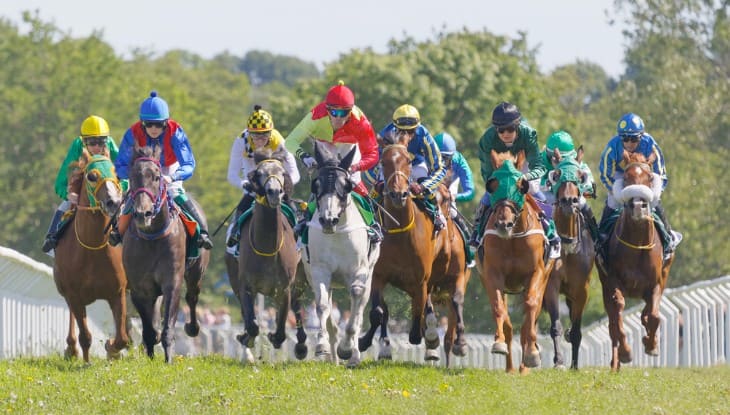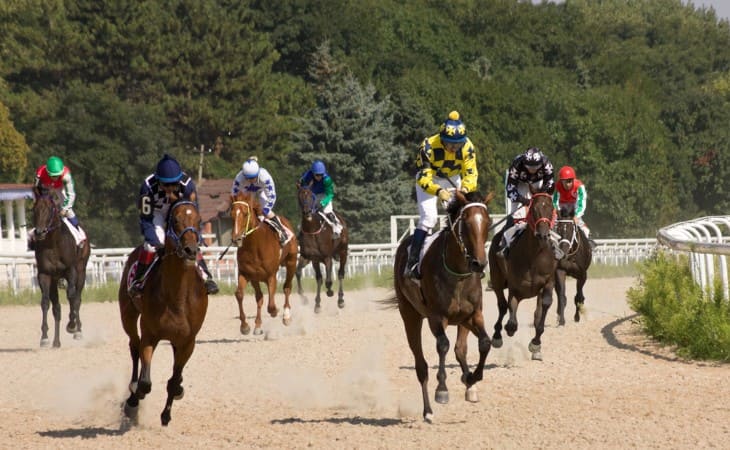- A Brief on WS (Wind Surgery) in Horse Racing
- Reasons for WS in Horse Racing
- The Process and Types of Wind Surgery in Horse Racing
- The Impact of Wind Surgery on Horse Racing Performance
- Regulations and Transparency in Reporting Wind Surgery
- The Debate Around Wind Surgery in the Racing Community
- Recovery and Rehabilitation After Wind Surgery
- Future Developments in Wind Surgery and Respiratory Health in Horses
- Final Takeaway
The world of horse racing is a jungle of terms and acronyms that may seem Greek to beginners and casual fans. One term that elicits questions is 'WS' an abbreviation for "wind surgery" in horses. What does WS mean in horse racing and how important is it? This article looks at WS in detail, considering why it matters, how necessary it is and its influence on the performance of a horse.
A Brief on WS (Wind Surgery) in Horse Racing
Normally abbreviated as WS, wind surgery plays a critical role in horse racing by addressing respiratory issues among racehorses. These surgeries are useful for horses with breathing problems particularly when they are engaged in high-intensity activities like running races.
During races, thoroughbred horses overwork their lungs pumping oxygenated blood to their muscles. Some unfortunate horses develop conditions that obstruct this process hence impacting negatively on their output and general health status.
In the case of wind surgery (WS), the word 'wind' refers to breathing. In equine sports, having a healthy respiratory system is crucially important. Horses which have difficulties in breathing cannot deliver maximum performances during a given task. This is where wind surgery comes into play.
It encompasses diverse surgical procedures meant to fix airflow-hindering diseases within the respiratory system. Such might include laryngeal hemiplegia whereby half of the larynx becomes immobile or dorsal displacement of the soft palate causing abnormalities in air passage.
Surgeries carried out under WS are not generic; they target specific problems identified for individual horses or treating individual cases. For instance, one common procedure involves a "tie-back" operation where the larynx is repositioned for better flow of air through the trachea.
These treatments involve more than just making a racehorse faster; they help keep horses healthy and able to breathe normally – an essential aspect of their lives and well-being.
Hence wind surgery prominently takes place since athletes who participate in this sport; horses are required to be in the best possible health. It also shows the role of veterinary medicine in sports hence pointing out how well these magnificent animals are taken care of. By addressing and treating respiratory issues, WS helps maintain the integrity and excitement of horse racing, ensuring each horse can compete safely and effectively.
Reasons for WS in Horse Racing
- High Oxygen Demand During Racing: Racehorses experience intense physical exertion during races, which demands a high level of oxygen. This implies that muscles require huge quantities of oxygen for their functioning. When a horse cannot breathe properly, it does not get enough oxygen to meet increased demand for it causing decreased performance as well as posing health risks. Respiratory systems are under considerable stress during races by horses. Horses that do not breathe correctly cannot run fast or long distances.
- Common Respiratory Conditions in Horses: Some horses develop conditions like laryngeal hemiplegia, soft palate issues, or epiglottic entrapment. During high-speed racing, these diseases obstruct the airway making it difficult for a horse to breathe. Just like humans, different illnesses affect thoroughbreds too. For racehorses, however, respiratory system anomalies are common causes of such difficulties experienced during races - leading to problems like roaring amongst others that highly impair racing capabilities.
- Enhancing Horse Welfare and Comfort: In addition to increased performance, wind surgery is essential for the comfort and welfare of a horse. Breathlessness or respiratory symptoms may cause misery to the victim thereby hindering its well-being.
The Process and Types of Wind Surgery in Horse Racing
Wind surgery in horse racing encompasses diverse procedures each addressing specific issues affecting respiration. They are aimed at resolving conditions that obstruct a horse's breathing ability during activities such as racing. Such surgeries are carried out by experienced veterinary surgeons who make use of their skills to ensure good health and enhanced performance of the animal.
A common type of wind surgery is a "tie-back" operation also called a laryngoplasty prosthetic. This procedure is necessary for treating paralysis of one side of the larynx causing blockage. In tie-back surgery, the immobile part of the voice box is relocated hence promoting easy passage and better inhalation.
Another surgical technique involved is known as "tie-forward" which could also be referred to as ventriculocordectomy. It involves removing some sections in the laryngeal ventricle that constrict airflow into the lungs. It tends to happen when there are vocal cord problems or other nearby structures associated with the horse.
Soft palate surgeries also come under wind surgery frequently. These encompass soft palate cautery or staphylectomy amongst others intended towards avoiding punctuation blocking air flow through it when it occurs more so during intense exercise on horses' soft palate which could displace abnormally obstructing these airways necessitating corrective measures through these interventions.
Wind surgery involves a proper execution plan that takes into consideration horse safety and health concerns as top priorities After undergoing this procedure, most horses need time off to heal properly before they can start racing again at full potential.
Wind surgery in horse racing consists of different specialised types of operations aimed at curing respiratory problems in horses. Consequently, this intervention becomes significant since these procedures are vital for the health, comfort and performance of horses enabling them to perform optimally while maintaining their well-being.

The Impact of Wind Surgery on Horse Racing Performance
- Improved Breathing Efficiency: A better breathing horse while racing is what wind surgery can achieve. Naturally, it improves the breathing potential of racehorses. It's not rare to find a horse getting wind surgery leading to a remarkable change in their breathing or air passage which is very important during any race. During races, horses need efficient respiration which allows them to maintain their speed and endurance by using oxygen effectively.
- Increased Endurance and Speed: Increased stamina and velocity are some of the effects of successful wind surgeries on horses. This is because they breathe more effectively enabling the muscles used in races to have enough oxygen supply. A major benefit associated with wind surgery entails increasing a horse's competitive skills. When breathing rate is improved so too does such an animal's ability to move faster during greater distances.
- Enhanced Horse Welfare and Comfort: Besides racing, improved respiratory function affects the general well-being and comfortability of horses as well. The operation can relieve pain from untreated respiratory issues among horses' thereby reducing discomfort caused by these conditions. Straight-up winning isn't everything as far as this type of operation is concerned but rather what makes animals feel okay.
Regulations and Transparency in Reporting Wind Surgery
When it comes to maintaining the integrity of horse racing, rules and regulations as well as transparency are paramount. Wind surgery can have a significant impact on a horse's performance, so this is especially true for such procedures. Numerous horse racing bodies have therefore regulated the disclosure of wind surgery to ensure fair play and informed decision making.
One major stipulation requires trainers to disclose any wind surgery that their horses have undergone before the next race. This declaration is made public, thus alerting gamblers, and competitors among others about the operation. For example, in the UK such disclosures are mandatory according to The British Horseracing Authority (BHA). This system fosters fairness by creating transparency.
The logic behind these laws is straightforward: wind surgery may provide a horse with an advantage over opponents; thus, it must be made public knowledge. Bettors get wiser selections, trainers and owners are more aware of what they are up against while fans get a deeper understanding of the game.
Moreover, these regulations help to ensure the welfare of the horses. By making wind surgery public, authorities can monitor the frequency and reasons for these surgeries, ensuring they are carried out in the best interest of the horse's health and not just for performance enhancement.
The regulations and transparency in reporting wind surgery are crucial for maintaining the integrity and fairness of horse racing. They ensure that all parties have access to important information about a horse's health and capabilities, thereby fostering a more honest and open sport. These measures also play a significant role in safeguarding the welfare of the horses, ensuring that their well-being is always a top priority.
The Debate Around Wind Surgery in the Racing Community
- Performance Enhancement vs. Welfare: A key aspect of the debate is whether wind surgery provides an unfair advantage by enhancing performance, or if it's primarily a welfare issue, addressing health concerns. Some in the racing community argue that wind surgery can give certain horses an edge over others, potentially skewing competition.
- Transparency and Fair Competition: The debate also touches on the importance of transparency in disclosing wind surgeries. Some feel that not enough information is provided about these procedures, which could affect betting and the fairness of races. The argument here revolves around whether enough is being done to inform bettors, trainers, and owners about horses that have undergone wind surgery.
- The Future of Wind Surgery Regulations: Discussions about potential changes to current regulations on wind surgery are ongoing. This includes debates on how to improve the reporting system and whether additional measures are needed to ensure the welfare of horses. As the understanding of wind surgery and its impact on horse racing evolves, so too might the regulations surrounding it.

Recovery and Rehabilitation After Wind Surgery
- Post-Surgery Rest and Monitoring: The initial phase after wind surgery involves a period of rest for the horse. This allows the surgical site to heal and reduces the risk of complications. After wind surgery, the horse must have a quiet and comfortable environment to recover.
- Gradual Return to Training: Once the horse has sufficiently recovered, the next step is a carefully planned return to training. This process is gradual to avoid putting too much strain on the horse too soon. The horse's return to training is carefully managed to ensure it doesn't overexert itself. Initially, the exercise is light, focusing on building up strength and endurance slowly.
- Ongoing Veterinary Assessments: Regular check-ups with the veterinarian are crucial during the rehabilitation process. These assessments ensure that the horse is recovering as expected and that there are no lingering issues from the surgery. Throughout the recovery and rehabilitation process, the horse's progress is closely monitored by veterinarians.
Future Developments in Wind Surgery and Respiratory Health in Horses
The field of veterinary medicine, particularly horse racing, is constantly evolving. As our understanding of equine health grows, so too do the techniques and methods used to treat respiratory issues in horses. In the future, we can expect to see significant developments in wind surgery and the overall approach to respiratory health in horses.
One area of potential advancement is in the precision and effectiveness of surgical procedures. As technology advances, surgeries could become less invasive and more targeted, reducing recovery time and improving outcomes. This would not only benefit the horses' performance but also their overall well-being.
Another area of focus could be on early detection and prevention. With better diagnostic tools, veterinarians might be able to identify respiratory issues before they become serious problems. This could lead to more preventative measures being taken, reducing the need for surgery and improving the overall health of racehorses.
There's also the potential for new treatments and therapies. Research into respiratory health could uncover new ways to treat conditions that currently require surgery. These treatments might be less invasive and more focused on long-term health and wellness.
Finally, there could be more emphasis on post-operative care and rehabilitation. As we learn more about how horses recover from these surgeries, the care they receive afterwards could become more tailored and effective. This would help horses return to racing more quickly and ensure they remain healthy and competitive for longer.
The future of wind surgery and respiratory health in horses is bright. With advancements in technology, diagnostics, treatment, and care, we can expect to see improvements in how these issues are managed. This will not only enhance the performance of racehorses but also ensure their health and comfort, which is always the top priority.
Final Takeaway
WS or wind surgery is a critical aspect of horse racing that addresses respiratory issues affecting racehorses. It involves various surgical procedures designed to improve airflow and breathing efficiency, which can significantly impact a horse's performance. While the effectiveness of these surgeries varies, they are generally aimed at enhancing the horse's welfare and racing capabilities.
The implementation of regulations around the declaration of wind surgeries reflects the sport's commitment to fairness and transparency. This allows stakeholders, including trainers, owners, bettors, and fans, to make informed decisions based on the health and condition of the horses.








